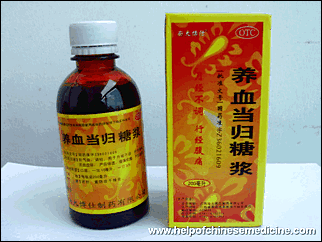A Classic Chinese tonic, it helps symptoms of dizziness, palpitations, poor memory. Good for irregular menstruation or postpartum weakness due to loss of blood.
Often used along with Women's Precious Pills, Nu Ke Ba Zhen Wan.
We can guarantee that the natural products from ShenYi Center of Chinese Medicine are 100% authentic and our prices are competitive in comparison to other herbal stores.
We ship via Hong Kong post.
Paypal and credit cards accepted. Most of the orders areshipped within 24 hours.
Please contact us for any enquiries:
info (at) helpofchinesemedicine.com


- Chinese Medicine for cardiovascular diseases and heart
- Chinese Medicine for gastro-intestinal disorders (poor appetite, indigestion, gastritis, diarrhea)
- Chinese Medicine for men (prostatitis, impotence etc.)
- Chinese Medicine for women (gynecological conditions, pre-menstrual syndrome, infertility)
- Chinese Medicine for liver syndromes (fatty liver, hepatitis)
- Chinese Medicine skin diseases (swelling, eczema, psoriasis)
- Chinese Medicine for asthma, bronchitis, chronic coughs
- Chinese Medicine for rheumatism, arthritis, osteoarthritis
- Chinese Medicine for hypertension
- Chinese Medicine for allergies
- Chinese Medicine for common cold and flu, sore throat
- Chinese Medicine for pain relieve
- Chinese Medicine for fatigue syndrome
- Chinese Medicine for weight loss
Effect of SBD.4A - a defined multicomponent preparation of Angelica sinensis - in periodontal regeneration models.
Zhao H, Alexeev A, Sharma V, Guzman LD, Bojanowski K.
Sunny BioDiscovery 2070A Walsh Ave. Santa Clara, CA 95050 and 722 East Main St. Santa Paula, CA 93060, USA.
Periodontitis is a major cause of tooth motility and loss, resulting in destruction of the supporting structures of the tooth, including periodontal ligaments and alveolar bone. Periodontal surgery can slow the progression of the disease, but is costly, invasive, limited by contraindications and technique-sensitive. Recently, non-invasive pharmacological treatments using proteinaceous biologicals have become available. Here, for the first time, the bone-regenerative capabilities of a non-proteinaceous biological - SBD.4A - a novel, stable multicomponent growth factor isolated from a medicinal plant Angelica sinensis are reported. SBD.4A was tested in osteoblast proliferation and differentiation systems, as well as in a fibroblast-secreted hyaluronic acid assay. Furthermore, SBD.4A was formulated in a slow release matrix and tested in the rat calvarial defect model. Apart from the previously reported strong stimulation of angiogenesis, fibroblast growth and collagen synthesis - the activities needed for periodontal regeneration - SBD.4A enhanced the deposition of hyaluronic acid and proliferation of osteoblasts in vitro, as well as bone regeneration in the rat calvarial defect model. Together, these results indicate the beneficial effect of SBD.4 on periodontal ligament and bone regeneration making the case for further development of this botanical growth factor. Hypothesis of active components in volatile oil from a Chinese herb formulation, 'Shao-Fu-Zhu-Yu decoction', using GC-MS and chemometrics.
Su S, Hua Y, Duan JA, Shang E, Tang Y, Bao X, Lu Y, Ding A.
Jiangsu Key Laboratory for TCM Formulae Research, Nanjing University of Chinese Medicine, Nanjing, PR China.
Traditional Chinese medicine (TCM) with few or no side effects has increasingly attracted attention all over the world. However, the bioactive components and the therapeutic mechanisms are usually not understood because of the complex chemical compositions of these medicines. In this paper, GC-MS coupled with a chemometric method was developed for analysis of active components in volatile oil from a Chinese herb formulation, "Shao-Fu-Zhu-Yu Decoction". The volatile oils, obtained by hydrodistillation from "Shao-Fu-Zhu-Yu Decoction" (SFZYD) and its constituent herbs with abundant volatile oil (Angelica sinensis, Ligusticum chuanxiong, Cinnamomum cassia, Foeniculum vulgare, Zingiber officinale), were chemically analyzed using GC-MS and bioassayed using oxytocin-induced uterine contraction assay in vitro. Then, a mathematic model relating the chemical compositions and their activities in inhibiting mice uterine contraction was established for hypothesis of the bioactive compounds based on chemometrics. As a result, nine compounds which might contribute to the inhibition of oxytocin-induced uterine contraction were selected, and the activities of some of them were further confirmed by our experiments and/or the literature. The data suggest that the developed method is helpful for screening bioactive components from complex mixtures, such as the extracts of TCM.
This is the page of Chinese medicine for women's disorders, you can buy Tang Kwei Gin online here.


